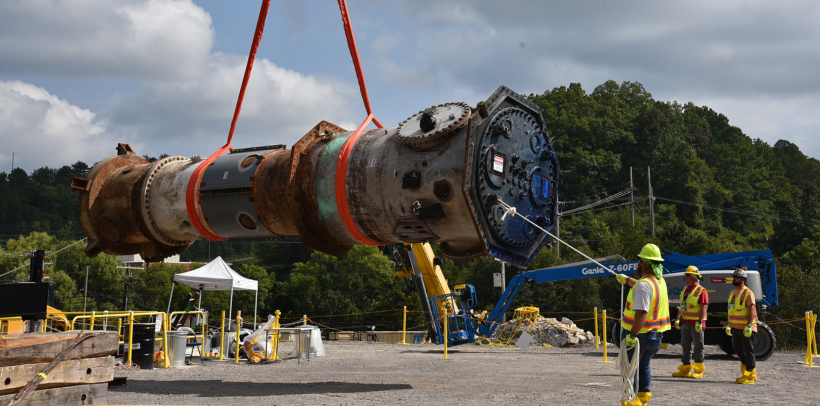Mining crews view progress in an ongoing mining tunnel, known as a drift, at the WIPP facility in New Mexico. (Photo: DOE)
The New Mexico Environment Department (NMED) signed a final order approving a 10-year permit renewal for the Waste Isolation Pilot Plant (WIPP), the nation’s deep geologic repository for defense-related transuranic (TRU) waste.
Contaminated soil is loaded in containers for disposal at the Oak Ridge Reservation in Tennessee. (Photo: DOE)
The Department of Energy’s Office of Environmental Management said a new regulatory partnership framework established in recent years by the Oak Ridge Office of Environmental Management (OREM), its contractor United Cleanup Oak Ridge (UCOR), the Environmental Protection Agency, and the Tennessee Department of Environment and Conservation (TDEC) is ushering in a new chapter of accelerated cleanup at the department’s Oak Ridge Reservation in Tennessee.
Ray Tran, an engineer for Savannah River tank farms, helps complete a timeline of SRS historical events as part of SRMC’s vision casting training initiative. (Photo: DOE)
More than 3,000 employees with Department of Energy contractor Savannah River Mission Completion (SRMC) participated in a vision casting initiative, learning more about the past, present, and future of the Savannah River Site’s liquid waste mission.
The Low Intensity Test Reactor structure is lifted from its housing and placed in a specialized carbon metal container for shipment for disposal. (Photo: DOE)
The Department of Energy’s Office of Environmental Management announced it has completed a second of its 2023 priorities at Oak Ridge in as many months with the demolition of the Low Intensity Test Reactor, known as Building 3005, at the Tennessee site.
Watch a video of Building 3005 and its decommissioning here.
Workers remove contaminated sediment from the SRS in South Carolina. A $19 million DOE grant will support state monitoring of the site. (Photo: DOE)
The Department of Energy’s Office of Environmental Management has awarded nearly $54 million in noncompetitive financial assistance grants and cooperative agreements to help support the office’s cleanup program. DOE-EM is responsible for environmental legacy cleanup of the effects of decades of nuclear weapons development and government-sponsored nuclear energy research.
A Department of Ecology inspector at the Hanford Site. (Photo: Department of Ecology)
Washington state’s Department of Ecology said it has reached a settlement with the Department of Energy over access to data the state described as “critical” to the cleanup of the Hanford Site near Richland, Wash.
A startup heater is removed from a melter in the Vit Plant’s Low-Activity Waste Facility. (Photo: DOE)
Workers at the Hanford Site’s Waste Treatment and Immobilization Plant, also known as the Vit Plant, have begun removing the first three of 18 temporary startup heaters, the Department of Energy announced on September 12. The startup heaters were used to raise the first of two 300-ton glass melters in the plant’s Low-Activity Waste Facility to its operating temperature of 2,100°F.
An elk herd at the DOE’s Hanford Site in Washington state. (Photo: DOE)
The Department of Energy has released the first request for information (RFI) related to the department’s Cleanup to Clean Energy initiative, which aims to repurpose certain DOE-owned lands, portions of which were previously used in the nation’s nuclear weapons program, into sites for clean energy generation.
Monticello nuclear power plant. (Photo: Xcel Energy)
The Minnesota Public Utilities Commission (PUC) has approved Xcel Energy’s request for a certificate of need to expand spent fuel storage at the utility’s Monticello nuclear power plant.
The additional storage, according to the PUC, requires installation of a second concrete support pad and modular concrete storage system designed to hold 14 additional steel canisters.
Xcel had requested increased outdoor storage to accommodate its plan to extend Monticello’s operational life by 10 years, to 2040.
Taking part in the Environmental Management Disposal Facility groundbreaking, from left, were Steve Arnette of Jacobs; Mark Whitney of Amentum,; Wade Creswell, a Roane Co., Tenn., executive; Brent Booker of the Laborers’ International Union of North America; Kevin Adkisson of North America’s Building Trades Unions; Jeaneanne Gettle of the EPA; Lt. Gov. Randy McNally; David Salyers of TDEC; Ken Rueter of UCOR; Jay Mullis of OREM; U.S. Rep. Chuck Fleischmann; and DOE-EM’s William “Ike” White. (Photo: DOE)
National, state, and local leaders joined the Department of Energy’s Oak Ridge Office of Environmental Management (OREM) and its lead cleanup contractor, United Cleanup Oak Ridge (UCOR), earlier this month to celebrate the groundbreaking for a new on-site disposal facility at the Oak Ridge Reservation in Tennessee.
Watch a video highlighting the Environmental Management Disposal Facility groundbreaking ceremony here.
Treated water is safer than world standards, essential for decommissioning
Washington, D.C. – The American Nuclear Society (ANS) supports the start of Japan’s controlled release of re-treated, diluted tritium wastewater into the sea from the Fukushima Daiichi Nuclear Power Plant (NPP), which sustained damage in the aftermath of a 2011 earthquake and tsunami.
The Pile Fuel Cladding Silo on the Sellafield site in West Cumbria, England. (Photo: Sellafield Ltd.)
After decades of planning and weeks of preparation and checks, the first batch of legacy waste has been retrieved from the Pile Fuel Cladding Silo at the Sellafield nuclear site in West Cumbria, England. According to Sellafield Ltd., the site license company, a state-of-the-art robotic arm was used to reach into the silo and, for the first time, remove and repackage the waste for longer-term storage.
These retrievals mark a significant achievement in progress toward the cleanup and decommissioning of one of the most hazardous buildings on the site, according to Sellafield Ltd., which made the announcement on August 16.
Watch a video about the Pile Fuel Cladding Silo and Sellafield’s waste retrieval operations here.
An October 2022 photo showing various SDUs at SRS. (Photo: DOE)
The Department of Energy’s Savannah River Site in South Carolina will begin a leak tightness test on what it called “the fourth megavolume saltstone disposal unit (SDU)” at the site.
A schematic illustration of a deep borehole repository assuming disposal into a bedrock. (Image: Sandia National Laboratories via IAEA)
The International Atomic Energy Agency is launching a new Coordinated Research Project (CRP) to increase international knowledge and drive progress toward testing deep borehole disposal for intermediate- and high-level radioactive waste.
















